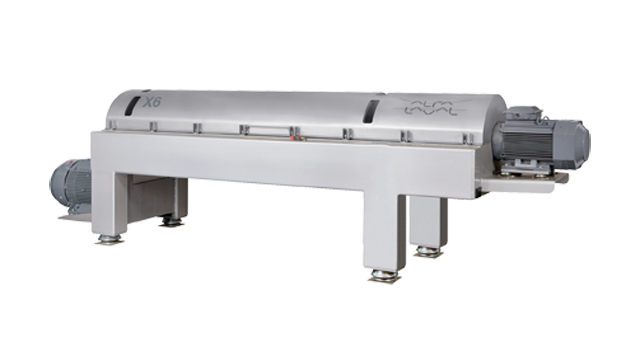Série X
Alfa Laval X-series decanter centrifuges are designed to provide a cost-effective operation in the olive oil chain, for both two-phase and three-phase operation.
Design features and benefits
The decanters feature a special system called Variable Dynamic Pressure (VDP). The geometry of the bowl and conveyor allows for a high pressure to be made on the solids before the discharge, thus being able to reach a higher level of dryness. Through the electronic control of the conveyor speed (differential speed) the level of this pressure can be adjusted and set to obtain the required degree of dryness.
Two-phase and three-phase
It is possible to use the same decanter for both two-phase and three-phase operation, on the basis of the differences in specific gravity.
In the three phase operation, the special features of the bowl geometry allow to utilize the so called ARA system. The ARA system controls the specific regulation of the decanter liquid level that both optimize quality of oil and water consumption.
The higher clarity of oil separated through the three phase process can be obtained with the addition of a lower amount of dilution water. This ensures a higher oil quality and reduced fresh water consumption. For the same reason, AISI 316 stainless steel is used throughout, and the casings are also made of stainless steel.
The design includes hinged casings for easy opening, maintenance and cleaning.
The decanters also have an overload protection system in either electronic or mechanical release version.
Fonctionnement
Comment fonctionne le décanteur d'huile d'olive Alfa Laval "Olive Oil X" ?
La conception du décanteur centrifuge garantit la séparation de la pâte d'olives entrant en trois phases – huile, matières solides et eau.
La pâte d'olives est acheminée dans le bol à travers une canne d’alimentation stationnaire et accélère doucement grâce à un rotor d'entrée.
La séparation a lieu dans un bol cylindrique horizontal monobloc équipé d'une vis convoyeuse. L'effort centrifuge provoque la sédimentation instantanée des matières solides sur la paroi du bol.
La convoyeuse tourne dans le même sens que le bol mais à un régime différent, ce qui provoque le déplacement des matières solides vers l'extrémité conique. Comme elle est plus légère, l'huile s'écoule vers l'intérieur et les matières solides se déplacent vers l'extérieur alors que l'eau reste au milieu. La séparation a lieu sur toute la longueur de la partie cylindrique du bol.
Les deux phases liquides s'écoulent vers leur sortie respective via un filtre vibrant, puis se déchargent dans des cuves de collecte.

